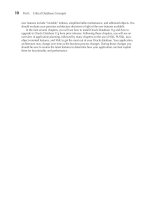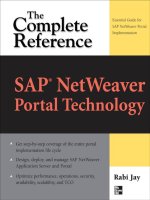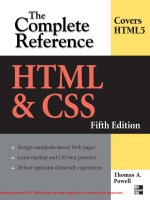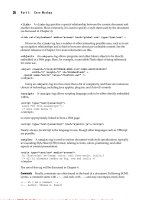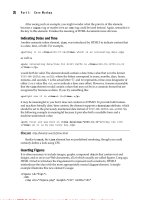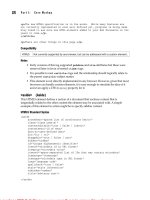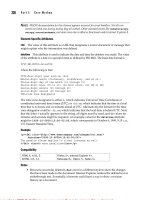Robot operating system (ROS) the complete reference (volume 1) ( TQL )
Bạn đang xem bản rút gọn của tài liệu. Xem và tải ngay bản đầy đủ của tài liệu tại đây (28.79 MB, 720 trang )
Studies in Computational Intelligence 625
Anis Koubaa Editor
Robot
Operating
System (ROS)
The Complete Reference (Volume 1)
Studies in Computational Intelligence
Volume 625
Series editor
Janusz Kacprzyk, Polish Academy of Sciences, Warsaw, Poland
e-mail:
About this Series
The series “Studies in Computational Intelligence” (SCI) publishes new developments and advances in the various areas of computational intelligence—quickly and
with a high quality. The intent is to cover the theory, applications, and design
methods of computational intelligence, as embedded in the fields of engineering,
computer science, physics and life sciences, as well as the methodologies behind
them. The series contains monographs, lecture notes and edited volumes in
computational intelligence spanning the areas of neural networks, connectionist
systems, genetic algorithms, evolutionary computation, artificial intelligence,
cellular automata, self-organizing systems, soft computing, fuzzy systems, and
hybrid intelligent systems. Of particular value to both the contributors and the
readership are the short publication timeframe and the worldwide distribution,
which enable both wide and rapid dissemination of research output.
More information about this series at />
Anis Koubaa
Editor
Robot Operating System
(ROS)
The Complete Reference (Volume 1)
123
Editor
Anis Koubaa
Prince Sultan University
Riyadh
Saudi Arabia
and
CISTER/INESC-TEC, ISEP
Polytechnic Institute of Porto
Porto
Portugal
ISSN 1860-949X
ISSN 1860-9503 (electronic)
Studies in Computational Intelligence
ISBN 978-3-319-26052-5
ISBN 978-3-319-26054-9 (eBook)
DOI 10.1007/978-3-319-26054-9
Library of Congress Control Number: 2015955867
Springer Cham Heidelberg New York Dordrecht London
© Springer International Publishing Switzerland 2016
This work is subject to copyright. All rights are reserved by the Publisher, whether the whole or part
of the material is concerned, specifically the rights of translation, reprinting, reuse of illustrations,
recitation, broadcasting, reproduction on microfilms or in any other physical way, and transmission
or information storage and retrieval, electronic adaptation, computer software, or by similar or dissimilar
methodology now known or hereafter developed.
The use of general descriptive names, registered names, trademarks, service marks, etc. in this
publication does not imply, even in the absence of a specific statement, that such names are exempt from
the relevant protective laws and regulations and therefore free for general use.
The publisher, the authors and the editors are safe to assume that the advice and information in this
book are believed to be true and accurate at the date of publication. Neither the publisher nor the
authors or the editors give a warranty, express or implied, with respect to the material contained herein or
for any errors or omissions that may have been made.
Printed on acid-free paper
Springer International Publishing AG Switzerland is part of Springer Science+Business Media
(www.springer.com)
Preface
ROS is an open-source robotic middleware for the large-scale development of
complex robotic systems. Although the research community is quite active in
developing applications with ROS and extending its features, the amount of references does not translate the huge amount of work being done.
The objective of the book is to provide the reader with a comprehensive coverage of the Robot Operating Systems (ROS) and the latest related systems, which
is currently considered as the main development framework for robotics
applications.
There are 27 chapters organized into eight parts. Part I presents the basics and
foundations of ROS. In Part II, four chapters deal with navigation, motion and
planning. Part III provides four examples of service and experimental robots.
Part IV deals with real-world deployment of applications. Part V presents
signal-processing tools for perception and sensing. Part VI provides software
engineering methodologies to design complex software with ROS. Simulations
frameworks are presented in Part VII. Finally, Part VIII presents advanced tools and
frameworks for ROS including multi-master extension, network introspection,
controllers and cognitive systems.
I believe that this book will be a valuable companion for ROS users and
developers to learn more about ROS capabilities and features.
January 2016
Anis Koubaa
v
Acknowledgements
The editor would like to acknowledge the support of King Abdulaziz City for
Science and Technology (KACST) through the funded research project entitled
“MyBot: A Personal Assistant Robot Case Study for Elderly People Care” under
the grant number 34-75, and also the support of Prince Sultan University.
vii
Acknowledgements to Reviewers
The Editor would like to thank the following reviewers for their great contributions
in the review process of the book by providing a quality feedback to authors.
Yasir
André S. De
Bence
Alfredo
Huimin
Dirk
Walter
Roberto
Joao
Ugo
Rafael
Andreas
Timo
Maram
Timm
Fadri
Péter
William
Jenssen
William
Markus
Chienliang
Mohamedfoued
Steven
Javed
Oliveira
Magyar
Soto
Lu
Thomas
Fetter Lages
Guzman
Fabro
Cupcic
Bekrvens
Bihlmaier
Röhling
Alajlan
Linder
Furrer
Fankhauser
Woodall
Chang
Morris
Achtelik
Fok
Sriti
Peters
Prince Sultan University
Universidade Tecnológica Federal do Paraná
PAL Robotics
Freescale Semiconductors
National University of Defense Technology
Open Source Robotics Foundation
Universidade Federal do Rio Grande do Sul
Robotnik
Universidade Tecnológica Federal do Paraná
SHADOW ROBOT COMPANY LTD.
University of Antwerp
Karlsruhe Institute of Technologie (KIT)
Fraunhofer FKIE
Al-Imam Mohamed bin Saud University
Social Robotics Lab, University of Freiburg
Autonomous Systems Lab, ETH Zurich
ETH Zurich
Open Source Robotics Foundation
Gaitech International Ltd.
Undefined
Autonomous Systems Lab, ETH Zurich
University of Texas at Austin
Al-Imam Muhammad Ibn Saud Islamic University
Open Source Robotics Foundation
ix
Contents
Part I
ROS Basics and Foundations
MoveIt!: An Introduction . . . . . . . . . . . . . . . . . . . . . . . . . . . . . . . . . .
Sachin Chitta
3
Hands-on Learning of ROS Using Common Hardware . . . . . . . . . . . . .
Andreas Bihlmaier and Heinz Wörn
29
Threaded Applications with the roscpp API . . . . . . . . . . . . . . . . . . . . .
Hunter L. Allen
51
Part II
Navigation, Motion and Planning
Writing Global Path Planners Plugins in ROS: A Tutorial . . . . . . . . . .
Maram Alajlan and Anis Koubâa
A Universal Grid Map Library: Implementation and Use Case
for Rough Terrain Navigation . . . . . . . . . . . . . . . . . . . . . . . . . . . . . . .
Péter Fankhauser and Marco Hutter
73
99
ROS Navigation: Concepts and Tutorial . . . . . . . . . . . . . . . . . . . . . . . 121
Rodrigo Longhi Guimarães, André Schneider de Oliveira,
João Alberto Fabro, Thiago Becker and Vinícius Amilgar Brenner
Localization and Navigation of a Climbing Robot Inside a LPG
Spherical Tank Based on Dual-LIDAR Scanning of Weld Beads . . . . . . 161
Ricardo S. da Veiga, Andre Schneider de Oliveira, Lucia Valeria Ramos de
Arruda and Flavio Neves Junior
Part III
Service and Experimental Robots
People Detection, Tracking and Visualization Using ROS
on a Mobile Service Robot . . . . . . . . . . . . . . . . . . . . . . . . . . . . . . . . . 187
Timm Linder and Kai O. Arras
xi
xii
Contents
A ROS-Based System for an Autonomous Service Robot . . . . . . . . . . . 215
Viktor Seib, Raphael Memmesheimer and Dietrich Paulus
Robotnik—Professional Service Robotics Applications with ROS. . . . . . 253
Roberto Guzman, Roman Navarro, Marc Beneto and Daniel Carbonell
Standardization of a Heterogeneous Robots Society Based on ROS . . . . 289
Igor Rodriguez, Ekaitz Jauregi, Aitzol Astigarraga, Txelo Ruiz
and Elena Lazkano
Part IV
Real-World Applications Deployment
ROS-Based Cognitive Surgical Robotics . . . . . . . . . . . . . . . . . . . . . . . . 317
Andreas Bihlmaier, Tim Beyl, Philip Nicolai, Mirko Kunze,
Julien Mintenbeck, Luzie Schreiter, Thorsten Brennecke,
Jessica Hutzl, Jörg Raczkowsky and Heinz Wörn
ROS in Space: A Case Study on Robonaut 2 . . . . . . . . . . . . . . . . . . . . 343
Julia Badger, Dustin Gooding, Kody Ensley, Kimberly Hambuchen
and Allison Thackston
ROS in the MOnarCH Project: A Case Study in Networked Robot
Systems . . . . . . . . . . . . . . . . . . . . . . . . . . . . . . . . . . . . . . . . . . . . . . . 375
João Messias, Rodrigo Ventura, Pedro Lima and João Sequeira
Case Study: Hyper-Spectral Mapping and Thermal Analysis . . . . . . . . 397
William Morris
Part V
Perception and Sensing
A Distributed Calibration Algorithm for Color and Range Camera
Networks . . . . . . . . . . . . . . . . . . . . . . . . . . . . . . . . . . . . . . . . . . . . . . 413
Filippo Basso, Riccardo Levorato, Matteo Munaro
and Emanuele Menegatti
Acoustic Source Localization for Robotics Networks . . . . . . . . . . . . . . . 437
Riccardo Levorato and Enrico Pagello
Part VI
Software Engineering with ROS
ROS Web Services: A Tutorial . . . . . . . . . . . . . . . . . . . . . . . . . . . . . . 463
Fatma Ellouze, Anis Koubâa and Habib Youssef
rapros: A ROS Package for Rapid Prototyping. . . . . . . . . . . . . . . . . . . 491
Luca Cavanini, Gionata Cimini, Alessandro Freddi, Gianluca Ippoliti
and Andrea Monteriù
HyperFlex: A Model Driven Toolchain for Designing and
Configuring Software Control Systems for Autonomous Robots . . . . . . 509
Davide Brugali and Luca Gherardi
Contents
xiii
Integration and Usage of a ROS-Based Whole Body Control
Software Framework. . . . . . . . . . . . . . . . . . . . . . . . . . . . . . . . . . . . . . 535
Chien-Liang Fok and Luis Sentis
Part VII
ROS Simulation Frameworks
Simulation of Closed Kinematic Chains in Realistic Environments
Using Gazebo . . . . . . . . . . . . . . . . . . . . . . . . . . . . . . . . . . . . . . . . . . . 567
Michael Bailey, Krystian Gebis and Miloš Žefran
RotorS—A Modular Gazebo MAV Simulator Framework . . . . . . . . . . 595
Fadri Furrer, Michael Burri, Markus Achtelik and Roland Siegwart
Part VIII
Advanced Tools for ROS
The ROS Multimaster Extension for Simplified Deployment
of Multi-Robot Systems . . . . . . . . . . . . . . . . . . . . . . . . . . . . . . . . . . . . 629
Alexander Tiderko, Frank Hoeller and Timo Röhling
Advanced ROS Network Introspection (ARNI). . . . . . . . . . . . . . . . . . . 651
Andreas Bihlmaier, Matthias Hadlich and Heinz Wörn
Implementation of Real-Time Joint Controllers . . . . . . . . . . . . . . . . . . 671
Walter Fetter Lages
LIDA Bridge—A ROS Interface to the LIDA
(Learning Intelligent Distribution Agent) Framework . . . . . . . . . . . . . . 703
Thiago Becker, André Schneider de Oliveira, João Alberto Fabro
and Rodrigo Longhi Guimarães
Part I
ROS Basics and Foundations
MoveIt!: An Introduction
Sachin Chitta
Abstract MoveIt! is state of the art software for mobile manipulation, incorporating
the latest advances in motion planning, manipulation, 3D perception, kinematics,
control and navigation. It provides an easy-to-use platform for developing advanced
robotics applications, evaluating new robot designs and building integrated robotics
products for industrial, commercial, R&D and other domains. MoveIt! is the most
widely used open-source software for manipulation and has been used on over 65
different robots. This tutorial is intended for both new and advanced users: it will
teach new users how to integrate MoveIt! with their robots while advanced users will
also be able to get information on features that they may not be familiar with.
1 Introduction
Robotics has undergone a transformational change over the last decade. The advent
of new open-source frameworks like ROS and MoveIt! has made robotics more
accessible to new users, both in research and consumer applications. In particular,
ROS has revolutionized the developers community, providing it with a set of tools,
infrastructure and best practices to build new applications and robots (like the Baxter
research robot). A key pillar of the ROS effort is the notion of not re-inventing the
wheel by providing easy to use libraries for different capabilities like navigation,
manipulation, control (and more).
MoveIt! provides the core functionality for manipulation in ROS. MoveIt! builds
on multiple pillars:
• A library of capabilities: MoveIt! provides a library of robotic capabilities for
manipulation, motion planning, control and mobile manipulation.
• A strong community: A strong community of users and developers that help in
maintaining and extending MoveIt! to new applications.
S. Chitta (B)
Kinema Systems Inc., Menlo Park, CA 94025, USA
e-mail:
URL:
© Springer International Publishing Switzerland 2016
A. Koubaa (ed.), Robot Operating System (ROS), Studies in Computational
Intelligence 625, DOI 10.1007/978-3-319-26054-9_1
3
4
S. Chitta
Fig. 1 Robots using MoveIt!
• Tools: A set of tools that allow new users to integrate MoveIt! with their robots
and advanced users to deploy new applications.
Figure 1 shows a list of robots that MoveIt! has been used with. The robots range
from industrial robots from all the leading vendors and research robots from all over
the world. The robots include single arm, dual-armed robots, mobile manipulation
systems, and humanoid robots. MoveIt! has been used in applications ranging from
search and rescue (the DARPA robotics challenge), unstructured autonomous pick
and place (with industrial robots like the UR5), mobile manipulation (with the PR2
and other robots), process tasks like painting and welding, with the (simulated)
Robonaut robot for target applications in the space station. MoveIt! has been used
or will be used by teams in the DARPA Robotics Challenge, the ROS-Industrial
Consortium, the upcoming Amazon Picking Challenge, the NASA sample retrieval
challenge.
2 A Brief History
MoveIt! evolved from the Arm Navigation framework [1, 2] in ROS. The Arm
Navigation framework was developed after the development of the base navigation
stack in ROS to provide the same functionality that was now available for base
navigation in ROS. It combined kinematics, motion planning, 3D perception and an
interface to control to provide the base functionality of moving an arm in unstructured
environments. The central node in the Arm Navigation framework, called move_arm,
was designed to be robot agnostic, i.e. usable with any robot. It connected to several
other nodes, for kinematics, motion planning, 3D perception and other capabilities,
to generate collision-free trajectories for robot arms. The Arm Navigation framework
was further combined with the ROS grasping pipeline to create, for the first time,
a general grasping and manipulation framework that could (and was) ported onto
several different robots with different kinematics and grippers.
MoveIt!: An Introduction
5
The Arm Navigation framework had several shortcomings. Each capability in the
framework was designed as a separate ROS node. This required sharing data (particularly environment data) across several processes. The need for synchronization
between the nodes led to several issues: (a) a mis-match of state between separate
nodes often resulted in motion plans that were invalid, (b) communication bottlenecks because of the need to send expensive 3D data to several different nodes and
(c) difficulty in extending the types of services offered by move_arm since it required
changing the structure of the node itself. MoveIt! was designed to address all of these
issues.
3 MoveIt! Architecture
The architecture of MoveIt! is shown in Fig. 2. The central node in MoveIt! is called
move_group. It is intended to be light-weight, managing different capabilities and
integrating kinematics, motion planning and perception. It uses a plugin-based architecture (adopted from ROS)—dramatically improving MoveIt!’s extensibility when
compared to Arm Navigation. The plugin architecture allows users to add and share
capabilities easily, e.g. a new implementation of pick and place or motion planning.
The use of plugins is a central feature of MoveIt! and differentiates it from Arm
Navigation.
Users can access the actions and services provided by move_group in one of three
ways:
• In C++: using the move_group_interface package that provides an easy to setup
interface to move_group using a C++ API. This API is primarily meant for
advanced users and is useful when creating higher-level capabilities.
Fig. 2 MoveIt! high-level architecture
6
S. Chitta
• In Python: using the moveit_commander package. This API is recommended for
scripting demos and for building applications.
• Through a GUI: using the Motion Planning plugin to Rviz (the ROS visualizer).
This API is recommended for visualization, initial interaction with robots through
MoveIt! and for quick demonstrations.
One of the primary design principles behind MoveIt! is to expose an easy to use
API for beginners to use while retaining access to the entire underlying API for
more advanced users. MoveIt! users can access any part of the functionality directly
if desired, allowing custom users to modify and architect their own applications.
MoveIt! builds on several component technologies, each of which we will describe
in brief detail.
3.1 Collision Checking
MoveIt! relies on the FCL [3] package for native collision checking. The collision
checking capabilities are implemented using a plugin architecture, allowing any
collision checker to be integrated with MoveIt!. FCL provides a state of the art
implementation of collision checking, including the ability to do continuous collision
checking. Collision checking is often the most expensive part of motion planning,
consuming almost 80–90 % of the time for generating a motion plan. The use of an
Allowed Collision Matrix allows a user to specify which pairs of bodies do
not need to be checked against each other, saving significant time. The Allowed
Collision Matrix is automatically configured by the MoveIt! Setup Assistant but
can also be modified online by the user.
3.2 Kinematics
MoveIt! utilizes a plugin-based architecture for solving inverse kinematics while
providing a native implementation of forward kinematics. Natively, MoveIt! uses a
numerical solver for inverse kinematics for any robot. Users are free to add their own
custom solvers, in particular analytic solvers are much faster than the native solver.
Examples of analytic solvers that are integrated with MoveIt! include the solver for
the PR2 robot. A popular plugin-based solver for MoveIt! is based on IKFast [4] and
offers analytic solvers for industrial arms that are generated (in code).
3.3 Motion Planning
MoveIt! works with motion planners through a plugin interface. This allows MoveIt!
to communicate with and use different motion planners from multiple libraries,
MoveIt!: An Introduction
7
making MoveIt! easily extensible. The interface to the motion planners is through
a ROS Action or service (offered by the move_group node). The default motion
planners for move_group are configured using the MoveIt! Setup Assistant. OMPL
(Open Motion Planning Library) is an open-source motion planning library that primarily implements randomized motion planners. MoveIt! integrates directly with
OMPL and uses the motion planners from that library as its primary/default set of
planners. The planners in OMPL are abstract; i.e. OMPL has no concept of a robot.
Instead, MoveIt! configures OMPL and provides the back-end for OMPL to work
with problems in Robotics.
3.4 Planning Scene
The planning scene is used to represent the world around the robot and also stores
the state of the robot itself. It is maintained by the planning scene monitor inside the
move group node. The planning scene monitor listens to:
• Robot State Information: on the joint_states topic and using transform information from the ROS TF transform tree.
• Sensor Information: using a world geometry monitor that integrates 3D occupancy information and other object information.
• World Geometry Information: from user input or other sources, e.g. from an
object recognition service.
The planning scene interface provides the primary interface for users to modify the
state of the world that the robot operates in.
3.5 3D Perception
3D perception in MoveIt! is handled by the occupancy map monitor. The Occupancy
map monitor uses an Octomap to maintain the occupancy map of the environment.
The Octomap can actually encode probabilistic information about individual cells
although this information is not currently used in MoveIt!. The Octomap can directly
be passed into FCL, the collision checking library that MoveIt! uses. Input to the
occupancy map monitor is from depth images, e.g. from an ASUS Xtion Pro Sensor
or the Kinect 2 sensor. The depth image occupancy map updater includes its own selffilter, i.e. it will remove visible parts of the robot from the depth map. It uses current
information about the robot (the robot state) to carry out this operation. Figure 3
shows the architecture corresponding to the 3D perception components in MoveIt!.
8
S. Chitta
Fig. 3 The 3D perception pipeline in MoveIt!: architecture
3.6 Trajectory Processing
MoveIt! includes a trajectory processing component. Motion planners will typically
only generate paths, i.e. there is no timing information associated with the paths.
MoveIt! includes trajectory processing routines that can work on these paths and
generate trajectories that are properly time-parameterized accounting for the maximum velocity and acceleration limits imposed on individual joints. These limits are
read from a seperate file specified for each robot.
3.7 Using This Tutorial
MoveIt! is a large package and it is impossible to cover it in its entirety in a book
chapter. This document serves as a reference for the tutorial that users can use but
must be used in conjunction with the online documentation on the MoveIt! website.
The online resource will remain the most up to date source of information on MoveIt!.
This paper will introduce the most important concepts in MoveIt! and also provide
helpful hints for new users. We assume that the user is already familiary with ROS.
Readers should go through the ROS Tutorials—in particular, they should learn about
ROS topics, services, using the ROS parameter server, ROS actions, the ROS build
system and the ROS transform infrastructure (TF).
The example URDFs and MoveIt! config packages used in this tutorial for the
Fanuc M10ia robot can be found in the examples repository.
MoveIt!: An Introduction
9
3.8 Installing MoveIt!
MoveIt! can easily be installed on a Ubuntu 14.04 distribution using ROS Indigo. The
most updated instructions for installing MoveIt! can be found on the MoveIt! installation page. It is recommended that most users follow the instructions for installing
from binaries. There are three steps to installing MoveIt!:
1. Install ROS—follow the latest instructions on the ROS installation page.
2. Install MoveIt!:
sudo apt-get install ros-indigo-moveit-full
3. Setup your environment:
source /opt/ros/indigo/setup.bash
4 Starting with MoveIt!: The Setup Assistant
The first step in working with MoveIt! is to use the MoveIt! Setup Assistant.1 The
setup assistant is designed to allow users to import new robots and create a MoveIt!
package for interacting, visualizing and simulating their robot (and associated workcell). The primary function of the setup assistant is to generate a Semantic Robot
Description Format (SRDF) file for the robot. It also generates a set of files that
allow the user to start a visualized demonstration of the robot instantly. We will not
describe the Setup Assistant in detail (the latest instructions can always be found
on the MoveIt! website [5]). We will instead focus on the parts of the process that
creates the most confusion for new users.
4.1 Start
To start the setup assistant:
rosrun moveit_setup_assistant moveit_setup_assistant
This will bring up a startup screen with two choices: Create New MoveIt! Configuration
Package or Edit Existing MoveIt! Configuration Package. Users should select Create New
MoveIt! Configuration Package for any new robot or workcell (even if the robots in the
workcells already have their own configuration package). Figure 4 illustrates this for
1 This
tutorial assumes that the user is using ROS Indigo on a Ubuntu 14.04 distribution.
10
S. Chitta
Fig. 4 Loading a Robot into the Setup Assistant
a Fanuc M10ia robot. Note that users can select either a URDF file or a xacro file
(often used to put together multiple robots).
The Setup Assistant is also capable of editing an existing configuration. The
primary reason to edit an existing configuration is to regenerate the Allowed Collision
Matrix (ACM). This matrix needs to be re-generated when any of the following
happens:
• The geometric description of your robot (URDF) has changed—i.e., the mesh
representation being used for the robot has changed. Note here that the collision
mesh representation is the key component of the URDF that MoveIt! uses. Changing the visual description of the robot while keeping the collision representation
unchanged will not require the MoveIt! Setup Assistant to be run again.
• The joint limits specified for the robot have changed—this changes the limits
that the Setup Assistant uses in sampling states for the Allowed Collision Matrix
(ACM). Failing to run the Setup Assistant again may result in a state where the
robot is allowed to move into configurations where it could be in collision with
itself or with other parts of the environment.
MoveIt!: An Introduction
11
4.2 Generating the Self-Collision Matrix
The key choice in generating the self-collision matrix is the number of random
samples to be generated. Using a higher number results in more samples being
generated but also slows down the process of generating the MoveIt! config package.
Selecting a lower number implies that fewer samples are generated and there is a
possibility that some collision checks may be wrongly disabled. We have found in
practice, that generating at least 10,000 samples (the default value) is a good practice.
Figure 5 shows what you should expect to see at the end of this step (Remember to
press the SAVE button!).
4.3 Add Virtual Joints
Virtual joints are sometimes required to specify where the robot is in the world. A
virtual joint could be related to the motion of a mobile base or it could be fixed, e.g.
for an industrial robot bolted to the ground. Virtual joints are not always required—
you can work with the default URDF model of the robot for most robots. If you do
add a virtual joint, remember that there has to be a source of transform information
for it (e.g. a localization module for a mobile base or a TF static transform publisher
Fig. 5 Generating the self-collision matrix
12
S. Chitta
Fig. 6 Adding virtual joints
for a fixed robot). Figure 6 illustrates the process of adding a fixed joint that attaches
the robot to the world.
4.4 Planning Groups
Planning groups bring together, semantically, different parts of the robot into a group,
e.g. an arm or a leg. The definition of groups is the primary function of the SRDF.
In the future, it is hoped that this information will move directly into the URDF.
Groups are typically defined by grouping a set of joints together. Every child link of
the joints is now a member of the group. Groups can also be defined as a chain by
specifying the first link and the last link in the chain—this is more convenient when
defining an arm or a leg.
In defining a group, you also have the opportunity to define a kinematic solver
for the group (note that this choice is optional). The default kinematic solver that
is always available for a group is the MoveIt! KDL Kinematics solver built around
the Kinematics Dynamics Library package (KDL). This solver will only work with
chains. It automatically checks (at startup) whether the group it is configured for
is a chain or a disjoint collection of joints. Custom kinematics solvers can also be
integrated into MoveIt! using a plugin architecture and will show up in the list of
MoveIt!: An Introduction
13
Fig. 7 Adding planning groups
choices for choosing a kinematics solver. Note that you may (and should) elect not
to initialize a kinematics solver for certain groups (e.g. a parallel jaw gripper).
Figure 7 show an example where a Fanuc robot arm is configured to have a group
that represents its six joints. The joints are added to the group using the “Add Joints”
button (which is the recommended button). You can also define a group using just
a link, e.g. to define an end-effector for the Fanuc M10ia robot, you would use the
tool0 link to define an end-effector group.
4.5 Robot Poses
The user may also add fixed poses of the robot into the SRDF. These poses are
often used to describe configurations that are useful in different situations, e.g. a
home position. These poses are then easily accessible using the internal C++ API
of MoveIt!. Figure 8 shows a pose defined for the Fanuc M10ia. Note that these
poses are user-defined and do not correspond to a native zero or home pose for the
robot.
14
S. Chitta
Fig. 8 Adding robot poses
4.6 Passive Joints
Certain joints in the robot can be designated as passive joints. This allows the various
components of MoveIt! to know that such joints cannot be used for planning or
control.
4.7 Adding End-Effectors (Optional)
Certain groups in the robot can be designated as end-effectors. This allows users to
interact through these groups using the Rviz interface. Figure 9 shows the gripper
group being designated as an end-effector.
4.8 Configuration Files
The last step in the MoveIt! Setup Assistant is to generate the configuration files that
MoveIt! will use (Fig. 10). Note that it is convention to name the generated MoveIt!
config package as robot_name_moveit_config. E.g. for the Fanuc robot used in our
MoveIt!: An Introduction
Fig. 9 Adding end-effectors
Fig. 10 Generating configuration files
15


